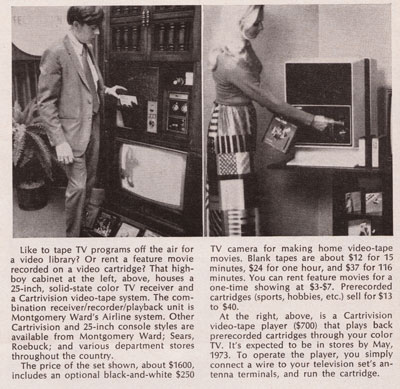
 |
Search | FAQ | US Titles | UK Titles | Memories | VaporWare | Digest | |||||||
| GuestBook | Classified | Chat | Products | Featured | Technical | Museum | ||||||||
| Downloads | Production | Fanfares | Music | Misc | Related | Contact | ||||||||
| CED in the History of Media Technology | ||||||||||||||

The AVCO Cartrivision system (for CARTRIdige teleVISION) was the first videocassette recorder to have prerecorded tapes for sale and rental in June 1972, three years before Sony's Betamax system hit the market. Cartrivision used a skip field recording technique that permitted nearly two hours of color recording to be put on a cartridge, albeit at considerably lower image quality than Sony's U-Matic. The cartridges also stood out in being square with the two internal reels stacked on top of each other. The initial Cartrivision catalog had 111 black cassettes (for sale only) and 200 red cassettes (for rental only and mostly movies).
The red cassettes had the unusual feature of only being playable once. There was no way for the consumer to rewind them at home without visibly tampering with the cartridge. To watch a red cassette a second time, the consumer had to pay the dealer $3 to $7 for a second rental. The dealer rewound the tape on a special machine and maintained an audit count of how many tapes had been processed. This system was oddly similar to the DIVX debacle of some 25 years later, but was necessary to convince Hollywood studios to release their material for Cartrivision (Sony had failed in their attempt to do this with U-Matic). Rental was further complicated by not having the material instantly available. Consumers generally had to request a rental title from the catalog, which was shipped by UPS and arrived at the dealer a few days later.
Cartrivision was initially available as part of the 25" television console shown at the left above. The system cost $1600, and could be purchased at Sears and Wards, which was a problem because most of the consumers frequenting these chains had nowhere near $1600 to spend in 1972. Besides extremely low sales, Cartrivision was hit with other financial difficulties, including sharp stock devaluations and the need to dispose of an entire warehouse of defective tapes. RCA also contributed to the demise of Cartrivision by making press announcements stating their superior SelectaVision MagTape system would soon be on the market. Avco finally decided to abandon Cartrivision in July 1973, taking a $1 million write-off. The compact standalone deck shown at the right above never reached the market, so most of the surviving Cartrivision units today are homemade boxes with the electronics mounted inside. It's more common to see Cartrivision as two loose pieces of exposed electronics, one piece being the tape transport unit and the other being the fishtank signal processing unit.